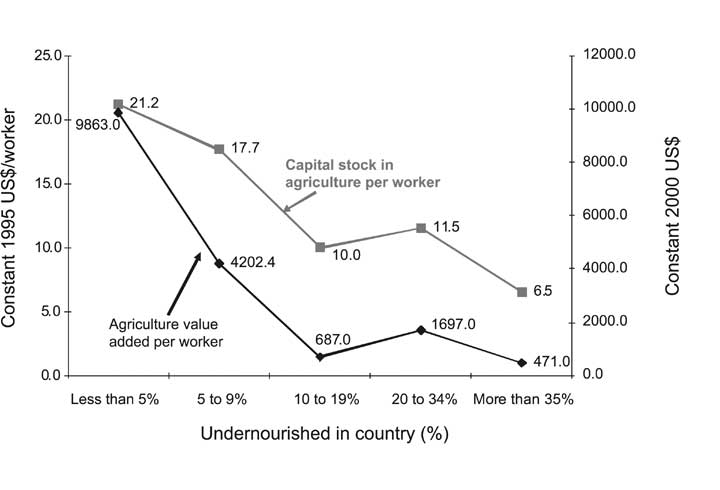
| Previous | Return to table of contents | Search Reports | Next |
| « Back to weltagrarbericht.de | ||
Setting the Scene | 15

Figure 1-3.
Nutritional status in 33 CWANA countries per capital stock in agriculture and
value added per worker. Source: FAO, 2006c
|
people and their livestock, coupled with the deregulation in access and use of rangelands, forests and land. Agricultural cropping and pastoralism become competitive, rather than complementary, forms of land use. Major production systems in North Africa and the Middle East. The production systems in North Africa and the Middle East are diverse. The most productive systems are able to nourish or provide livelihoods for many people. The biggest portion (85%) of the area is covered by less productive systems: pastoral farming (3 people km-2) and sparse farming (6 people km-2). The most productive agriculture is concentrated in the remaining 15% of the land area because of greater land and water resources. The population density in large-scale irrigated agriculture is the highest. The total cultivated area is irrigated. In the Middle East and North Africa, irrigation is a way to intensify agriculture. Highland mixed farming and rainfed mixed farming also have high population densities. These systems have family farms and integration between agriculture and livestock, essential for income diversification and managing soil fertility. They are diversified because they integrate cereal and legumes, fruit trees, fodder and livestock. These systems are productive because of the availability of good soils and rainfall. Obviously, resource scarcity determines the productivity of each system and its natural resource management. In the arid zone reliable agriculture is possible through irrigation and nomadism. Rainfed agriculture is widespread in the semiarid zone. Two major elements should be looked at to intensify agriculture in this region:
The percentage of irrigated area, cultivated area and type of land and water management varies with production system (Table 1-4). As water resources are scarce, irrigation |
efficiency is important, but it is low and rarely exceeds 50 percent. Production might be intensified by improving irrigation efficiency through better resource management and introduction of technical innovations, especially irrigation water-saving techniques. Major production systems in Central Asia. In Central Asia, many countries from the former Soviet Union have a lot of land issues. Land allocation, land reform and restructuring and the transition to open markets have not yet been achieved. Land issues have negative effects on production. The most productive in central Asia are the highland mixed rice and wheat farming systems. Those systems, set in Pakistan and Afghanistan, have benefited from the Green Revolution, especially the rice or wheat farming system. High-yielding varieties, mechanization and agrochemicals boosted agricultural production. These two systems are highly intensified and the ratio of irrigated area to the total cultivated area is large: 86% of the cultivated area is irrigated, with a population density of about 40 people per km². Similar to the Middle East and North Africa, two major elements determine agricultural production and food security: land and water. There is scope for extending the irrigated area, and therefore agricultural production, especially in Turkey. All conditions are set, socially and economically, to boost agricultural production in Turkey. It has the political will, water resources, water-management policies and irrigation projects, such as the South Eastern Anatolian Project (GAP). Pakistan and Afghanistan have only limited potential to extend irrigated area because water resources are decreasing, especially groundwater. Intensification of agricultural production may occur by introducing new water-storage and water-saving practices. Although, the share of irrigated areas in cultivated areas is very low (10%) in the countries of the former Soviet Union, there is no scope for implementing large-scale irrigation schemes as |
| Previous | Return to table of contents | Search Reports | Next |
| « Back to weltagrarbericht.de | ||